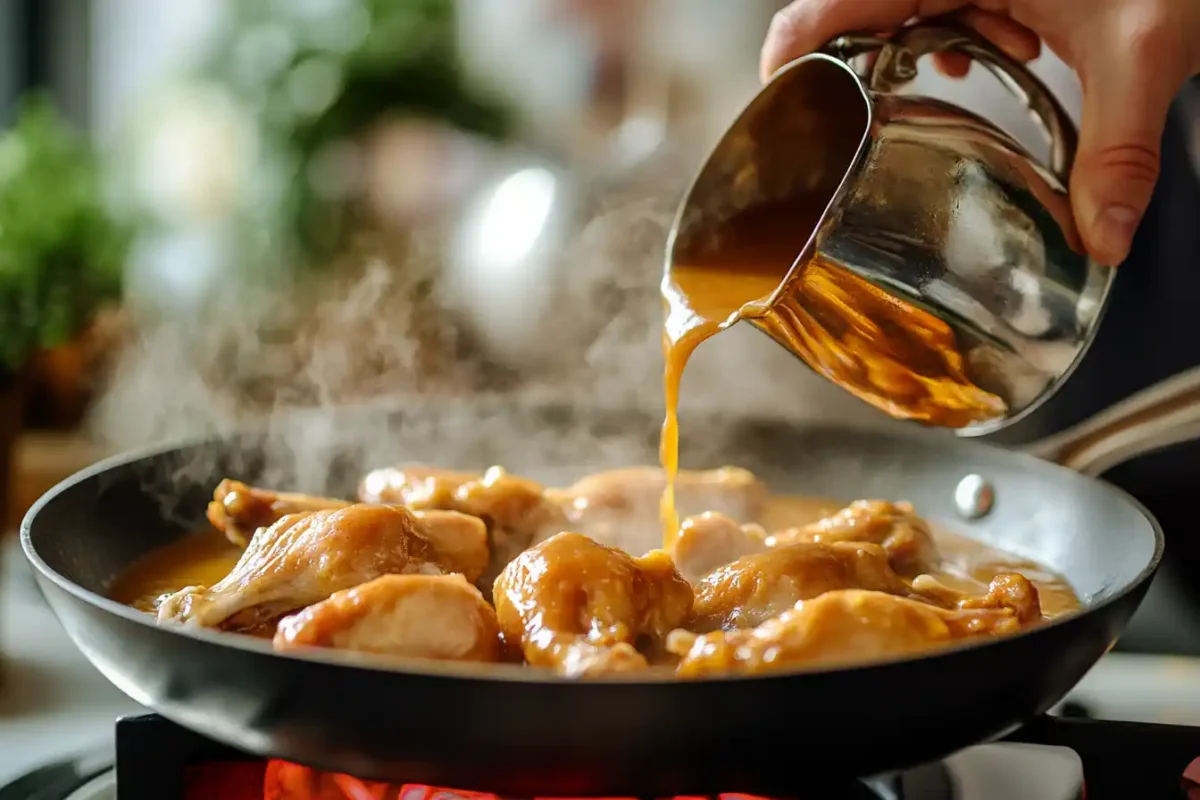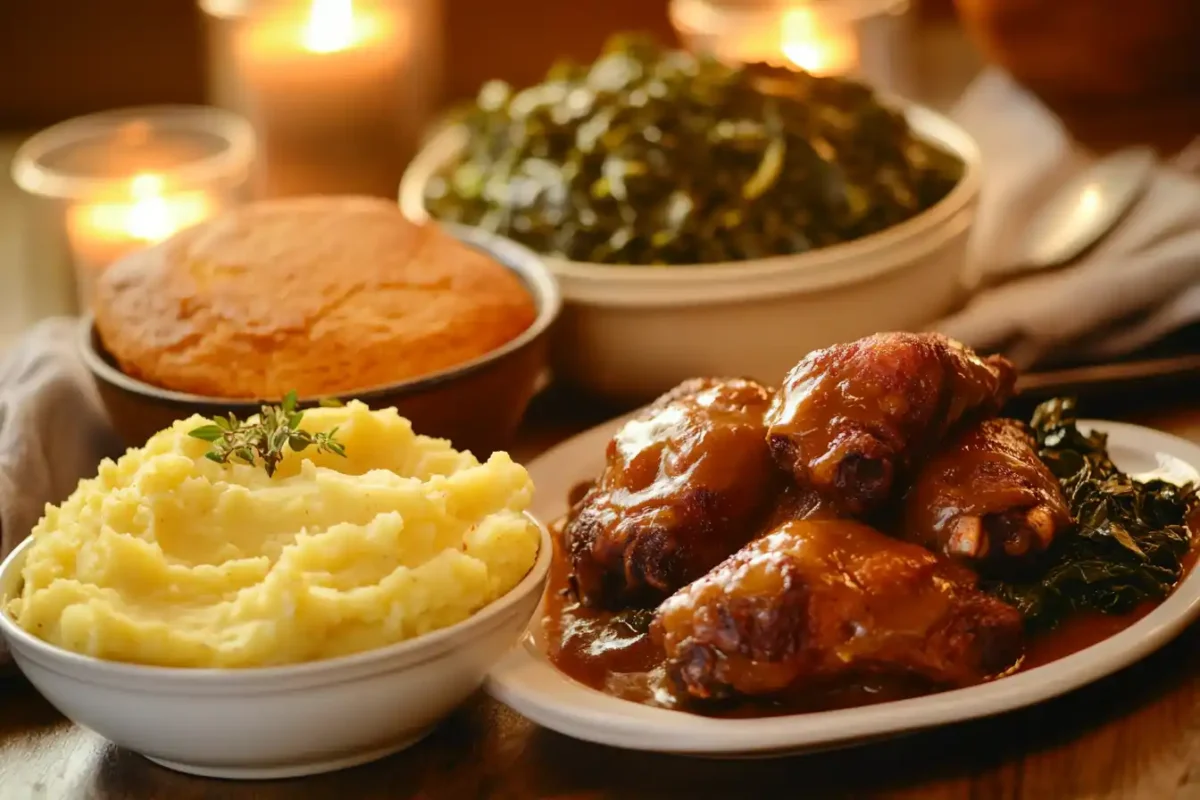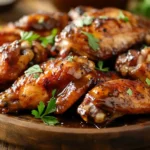Why You’ll Love Smothered Turkey Wings
There’s something truly special about a plate of smothered turkey wings. The rich, slow-cooked gravy, the fall-off-the-bone tenderness, and the deep, soulful flavors make this dish a comfort food classic. Whether you grew up eating them at Sunday dinners or you’re trying them for the first time, one thing is certain once you take a bite, you’ll want them again and again.
But let’s be honest, not all smothered turkey wings recipes turn out perfect. Maybe your turkey wings come out too tough, or the gravy is too runny. Don’t worry! This guide will walk you through everything you need to know to make smothered turkey wings that are juicy, flavorful, and absolutely delicious.
By the time you finish reading, you’ll know the best ingredients, cooking methods, and secret tips to master this dish. Plus, we’ll cover the most common mistakes and how to fix them. Ready to get started?
Ingredients for the Perfect Smothered Turkey Wings
The key to making the best smothered turkey wings recipe is using the right ingredients. Here’s everything you need:
Choosing the Best Turkey Wings
Not all turkey wings are created equal! When shopping, look for fresh, plump wings with no discoloration. If frozen, ensure they are properly thawed before cooking. Here’s a quick guide to turkey wing options:
| Type | Description | Best Use |
|---|---|---|
| Whole Turkey Wings | Includes both the drumette and the flat portion | Great for larger portions, slow cooking |
| Split Turkey Wings | Wings are cut into two parts | Ideal for even cooking and smaller servings |
| Pre-Seasoned Turkey Wings | Marinated or seasoned in advance | Good for convenience, but homemade seasoning is better |
Essential Spices and Seasonings for Maximum Flavor
To get that deep, rich taste, the seasoning mix is key. Here’s what you’ll need:
- Salt and black pepper: Essential for bringing out the flavors.
- Garlic powder and onion powder: Add depth to the dish.
- Smoked paprika: Gives a subtle smoky kick.
- Cajun seasoning: Adds a touch of spice and Southern flair.
- Thyme and rosemary: Perfect for that aromatic, slow-cooked taste.
Other Key Ingredients for a Rich, Savory Gravy
The gravy is what makes smothered turkey wings truly unforgettable. Here’s what you’ll need to make it perfect:
- Flour: Acts as a thickening agent for the gravy.
- Chicken broth: Gives the gravy a rich, savory base.
- Butter: Adds creaminess and depth to the sauce.
- Onions and bell peppers: Caramelized for extra flavor.
Step-by-Step Instructions: How to Make Smothered Turkey Wings
Follow these simple steps to create the best smothered turkey wings recipe ever.
Step 1: Preparing the Turkey Wings for Cooking
- Rinse the turkey wings under cold water and pat them dry with paper towels.
- Season generously with salt, black pepper, garlic powder, onion powder, smoked paprika, and Cajun seasoning.
- Let the wings sit for at least 30 minutes to absorb the flavors.
Step 2: Searing the Turkey Wings for Extra Flavor
Searing locks in juices and enhances the overall taste. Here’s how:
- Heat a large skillet over medium-high heat and add a tablespoon of oil.
- Brown the turkey wings on each side for about 3-4 minutes until golden brown.
- Remove the wings from the skillet and set them aside.
Step 3: Making the Perfect Homemade Gravy
The gravy is what brings the whole dish together. Follow these steps:
- In the same skillet, melt butter and sauté onions and bell peppers until soft.
- Sprinkle in flour and stir continuously for 1-2 minutes to create a roux.
- Slowly pour in chicken broth while stirring to prevent lumps.
- Let the gravy simmer for 5 minutes until thick and smooth.
Step 4: Slow Cooking vs. Baking: Which Method is Best?
| Method | Cooking Time | Best For |
|---|---|---|
| Oven Baking | 2.5 – 3 hours at 325°F (165°C) | Rich, oven-roasted flavor |
| Slow Cooking | 6 – 8 hours on low | Ultra-tender, fall-off-the-bone wings |
Baking Instructions
- Preheat your oven to 325°F (165°C).
- Place the seared turkey wings in a baking dish and pour the gravy over them.
- Cover with foil and bake for 2.5 to 3 hours, basting occasionally.
Slow Cooker Instructions
- Place turkey wings in a slow cooker and pour the gravy over them.
- Cover and cook on low for 6-8 hours or high for 4 hours.
Common Problems and How to Fix Them

Even with the best ingredients and preparation, things can still go wrong when making smothered turkey wings. Here are some of the most common issues and how to fix them.
Problem 1: Why Are My Turkey Wings Tough?
There’s nothing worse than biting into a turkey wing that’s tough and chewy instead of tender and juicy. This happens when the meat hasn’t cooked long enough or at the right temperature.
✔ Why It Happens:
- The turkey wings weren’t cooked long enough.
- The cooking temperature was too high, causing the meat to dry out.
- Not enough moisture was used during cooking.
✔ How to Fix It:
- Make sure you’re cooking the wings at a low and slow temperature (325°F in the oven or low heat in a slow cooker).
- Cover the dish tightly with foil or a lid to trap moisture.
- If the wings are still tough, let them cook for an additional 30-45 minutes until they become tender.
Problem 2: How to Prevent the Gravy from Being Too Thin or Too Thick
The gravy is one of the best parts of smothered turkey wings, but getting the perfect consistency can be tricky.
✔ Why It Happens:
- Too much broth or liquid can make the gravy too thin.
- Not enough thickening agents (flour or cornstarch) can lead to a watery gravy.
- Over-thickening can cause a paste-like texture.
✔ How to Fix It:
| Problem | Solution |
|---|---|
| Gravy too thin | Mix 1 tablespoon of cornstarch with 2 tablespoons of water, then stir it into the gravy and simmer until thickened. |
| Gravy too thick | Add a splash of chicken broth or warm water and stir until desired consistency is reached. |
| Gravy lacks richness | Whisk in a small amount of butter or cream for a smoother texture. |
Problem 3: How to Add More Flavor if the Dish Tastes Bland
If your smothered turkey wings are missing that bold, Southern-style taste, it could be due to under-seasoning.
✔ Why It Happens:
- Not enough seasoning was used.
- Only salt and pepper were added without depth from herbs and spices.
- Low-quality broth diluted the flavor.
✔ How to Fix It:
- Add more garlic powder, onion powder, paprika, and Cajun seasoning to the gravy.
- Mix in a splash of Worcestershire sauce or soy sauce for extra umami flavor.
- Use homemade or high-quality chicken broth instead of water for a richer taste.
Best Side Dishes to Serve with Smothered Turkey Wings
A good plate of smothered turkey wings is even better with the right side dishes. Here are some classic and healthier options.

Classic Southern Sides That Pair Perfectly
| Side Dish | Description |
|---|---|
| Mashed Potatoes | Rich, creamy potatoes that soak up the gravy perfectly. |
| Collard Greens | A Southern staple cooked with smoked turkey or ham hock. |
| Cornbread | Buttery and slightly sweet, perfect for sopping up extra gravy. |
| Mac and Cheese | Cheesy, creamy, and comforting—an ideal companion. |
Healthier Side Dish Alternatives
- Cauliflower Mash: A low-carb alternative to mashed potatoes.
- Steamed Green Beans: Adds freshness and crunch to the meal.
- Quinoa or Brown Rice: A high-fiber, protein-rich base to soak up the gravy.
- Roasted Sweet Potatoes: A naturally sweet and nutrient-dense side.
Tips and Tricks for the Best Smothered Turkey Wings
✔ How to Get the Most Tender Meat
- Use a slow cooker for ultra-tender results.
- Let the turkey wings rest after cooking to allow juices to redistribute.
- Cut the wings into sections for even cooking.
✔ How to Store and Reheat Leftovers
Got leftovers? Here’s how to keep them fresh and flavorful:
| Storage Method | How Long? | Best Practices |
|---|---|---|
| Refrigerator | 3-4 days | Store in an airtight container with some gravy to keep it moist. |
| Freezer | 2-3 months | Freeze in a freezer-safe container, leaving some room for expansion. |
✔ Best Way to Reheat
- Oven: Reheat at 300°F (150°C) covered with foil for 20 minutes.
- Stovetop: Warm in a skillet over low heat with extra broth to prevent drying out.
- Microwave: Heat in 1-minute intervals with a splash of water or gravy to keep it moist.
Frequently Asked Questions About Smothered Turkey Wings
Before you get started on making the perfect smothered turkey wings recipe, let’s go over some frequently asked questions to help you cook with confidence.
Can I Make This Recipe in a Slow Cooker?
Yes! Slow cooking is one of the best ways to achieve tender, fall-off-the-bone smothered turkey wings. Simply sear the turkey wings first, make your gravy, and then let everything cook on low for 6-8 hours. The result? Extra juicy wings with rich, flavorful gravy.
What Can I Use Instead of Turkey Wings?
If you can’t find turkey wings, you can substitute other cuts of turkey or even chicken. Here are some great alternatives:
| Substitute | Best Cooking Method | Texture & Flavor |
|---|---|---|
| Turkey Drumsticks | Slow cook or oven bake | Similar flavor but meatier |
| Turkey Thighs | Slow cook or braise | Juicier and more tender |
| Chicken Wings | Oven bake or slow cook | Smaller but cooks faster |
| Chicken Drumsticks | Oven bake or slow cook | Great alternative for smaller portions |
Can I Make Smothered Turkey Wings Ahead of Time?
Absolutely! This dish actually tastes even better the next day as the flavors continue to develop. To make ahead:
- Cook the turkey wings and gravy as directed.
- Let everything cool and store in an airtight container in the refrigerator for up to 3 days.
- Reheat in the oven at 300°F (150°C) or on the stovetop over low heat.
Delicious Variations of Smothered Turkey Wings
Want to change things up? Here are some creative ways to put a unique spin on this smothered turkey wings recipe.
✔ Cajun-Style Smothered Turkey Wings
Turn up the heat with bold Louisiana flavors!
- Add extra Cajun seasoning and a dash of hot sauce to the gravy.
- Use smoked turkey wings for a deeper flavor.
- Serve over dirty rice for a true Southern experience.
✔ Creamy Garlic Smothered Turkey Wings
If you love rich, creamy dishes, try this variation.
- Replace chicken broth with a mix of heavy cream and broth.
- Add minced garlic and parmesan cheese for extra richness.
- Serve over mashed potatoes for the ultimate comfort meal.
✔ Smothered Turkey Wings with Mushrooms
Mushrooms add a meaty texture and umami flavor to the gravy.
- Sautee mushrooms along with onions and bell peppers.
- Use a splash of Worcestershire sauce to enhance the umami taste.
- Garnish with fresh thyme for an earthy finish.
Explore More Delicious Recipes
- Why Do You Soak Turkey Wings in Vinegar?
- The Ultimate Turkey Injection Recipe
- Ground Turkey Casserole Recipes
Conclusion: Enjoy Your Perfectly Smothered Turkey Wings
Smothered turkey wings are a true Southern classic, combining tender meat with rich, flavorful gravy for a dish that’s both satisfying and comforting. Whether you bake them in the oven, let them slow cook all day, or try one of the delicious variations, you’re guaranteed to end up with a meal that will have everyone coming back for seconds.
Now that you have all the tips, tricks, and step-by-step instructions, it’s time to put your skills to the test! Try this recipe, experiment with different flavors, and most importantly—enjoy every bite.
Have you made smothered turkey wings before? Let us know in the comments! And don’t forget to follow us on Facebook for more delicious recipes.
Happy cooking with Rita chef ❤️!
Print
Smothered Turkey Wings Recipe
- Total Time: 3 hours 15 minutes
- Yield: 4 servings 1x
- Diet: Gluten Free
Description
This smothered turkey wings recipe delivers tender, juicy wings slow-cooked in a rich homemade gravy. A flavorful Southern-style dish perfect for family dinners.
Ingredients
Turkey wings 3 pounds
Salt 1 teaspoon
Black pepper 1 teaspoon
Garlic powder 1 teaspoon
Onion powder 1 teaspoon
Smoked paprika 1 teaspoon
Cajun seasoning 1 teaspoon
Olive oil 2 tablespoons
Butter 2 tablespoons
Onion sliced 1 large
Bell pepper sliced 1
Flour 2 tablespoons
Chicken broth 2 cups
Worcestershire sauce 1 tablespoon
Thyme dried 1 teaspoon
Instructions
Rinse and pat dry the turkey wings then season with salt black pepper garlic powder onion powder smoked paprika and Cajun seasoning
Heat olive oil in a large skillet over medium heat then brown the turkey wings on both sides for about 3 to 4 minutes per side
Remove the turkey wings and set aside then melt butter in the same skillet and sauté sliced onions and bell peppers until soft
Sprinkle in the flour stirring continuously for 1 to 2 minutes to create a roux
Slowly pour in the chicken broth while stirring until the mixture thickens into a smooth gravy
Add Worcestershire sauce and thyme then return the turkey wings to the skillet and coat them with the gravy
Transfer everything to a baking dish cover with foil and bake at 325°F 165°C for 2.5 to 3 hours until the wings are tender
Serve hot with mashed potatoes rice or cornbread
Notes
For extra tenderness cook the turkey wings in a slow cooker on low for 6 to 8 hours
Use smoked turkey wings for a deeper flavor
If the gravy is too thin mix 1 tablespoon cornstarch with 2 tablespoons water and stir into the sauce before serving
- Prep Time: 15 minutes
- Cook Time: 3 hours
- Category: Main Dish
- Method: Slow Cooking or Baking
- Cuisine: Southern
Nutrition
- Serving Size: 1 serving
- Calories: 480
- Sugar: 3g
- Sodium: 850mg
- Fat: 25g
- Saturated Fat: 8g
- Unsaturated Fat: 12g
- Trans Fat: 0g
- Carbohydrates: 12g
- Fiber: 2g
- Protein: 50g
- Cholesterol: 130mg

